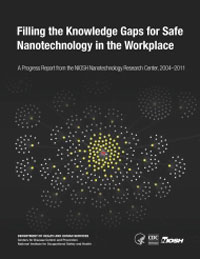| Nov 09, 2012 | |
Filling the knowledge gaps for safe nanotechnology in the workplace |
|
| (Nanowerk News) The NIOSH Nanotechnology Research Center (NTRC) has published a progress report – "Filling the Knowledge Gaps for Safe Nanotechnology in the Workplace" (pdf). | |
In 2004, the National Institute for Occupational Safety and Health (NIOSH) established the Nanotechnology Research Center (NTRC) to address the occupational safety and health concerns that might be associated with this new technology.
 Through the NTRC, NIOSH forged partnerships with other government agencies, countries, academia, industry, labor, and nongovernmental organizations to conduct research on the potential workplace implications and the beneficial applications of nanotechnology. A critical element of the research program is to conduct research on the potential health effects of worker exposure to engineered nanomaterials and to develop guidance in preventing exposure. In 2007 and 2009, NIOSH published progress reports detailing the accomplishments of the NTRC, including the results of ongoing laboratory and field research and the publication of technical and other guidance documents on the safe handling of engineered nanomaterials (see Progress Toward Safe Nanotechnology in the Workplace, www.cdc.gov/niosh/topics/nanotech/pubs.html). This 2012 update presents the program accomplishments of the NTRC from its inception in 2004 through 2011. It includes an analysis of the progress made toward accomplishing the goals and objectives of the NIOSH Strategic Plan for Nanotechnology Research and toward addressing the goals and research needs identified in the U.S. National Nanotechnology Initiative (NNI) Environmental, Health, and Safety (EHS) research strategy. The NTRC continues to support and promote the responsible development of nanotechnology through its ongoing research program and its contributions to the development of guidelines for hazard identification, exposure assessment, and risk characterization that can be used to develop and implement effective risk management practices. |
| Source: NIOSH |
